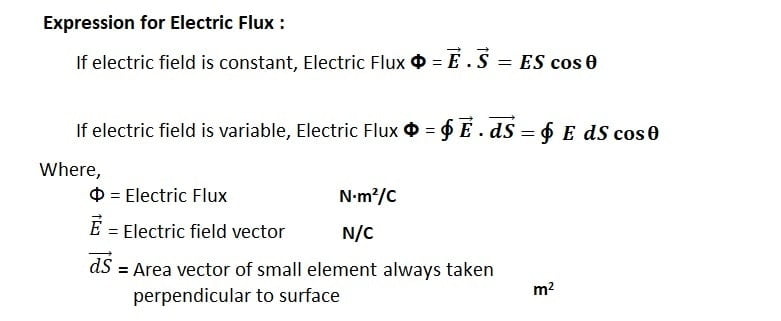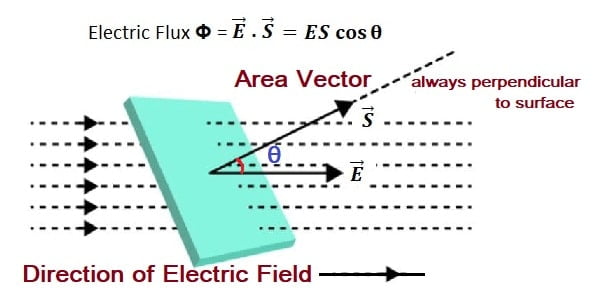Electric Flux
Electric flux is the measure of the number of electric field lines passing through a surface perpendicularly. It measures strength of electric field in a region. It is represented by symbol (Φ).
It is measured as a dot product of Intensity of Electric Field and Area Vector.

Since, Φ is dot product of two vectors so, it is scalar quantity.


Table of Contents
SI unit of Electric Flux
SI unit of Electric Flux is volt per meter ( V / m ) or the newton-meter square per coulomb ( N·m²/C )
Φ = (E) · (A )· (cos θ) = (N / C) . (m²) . (Unit less cos θ) = N·m²/C
Φ = (E) · (A )· (cos θ) = (V / m) . (m²) . (Unit less cos θ) = V . m
👉🖱 State and Prove Gauss Theorem
Questions and Answers from Electric Flux
Q1: What is electric flux?
Answer : Electric flux is the measure of the number of electric field lines passing through a surface perpendicularly.
Q2: What is the formula for electric flux?
Answer : The formula for electric flux is Φ = E S cosθ
Where Φ represents the electric flux, E is the electric field, A is the area of the surface, and θ is the angle between the electric field and the Area Vector (normal to the surface).
Q3: What is SI unit of electric flux?
Answer : The SI unit of electric flux is the volt / meter (V/m) or the newton-meter squared per coulomb (N·m²/C).
Q4: On What factors does the magnitude of electric flux depend?
Answer : The magnitude of electric flux depends on (i) the strength of the electric field, (ii) the area of the surface, and (iii) the angle between the electric field and the area vector.
Q5: What is the significance of the angle θ in the formula for electric flux?
Answer : The angle θ represents the angle between the electric field and the area vector (normal to the surface). It determines how much of the electric field lines pass through the surface, affecting the overall flux.
Q6: How is electric flux affected when the surface area is increased?
Answer : When the surface area is increased, the electric flux also increases, assuming the electric field strength and the angle θ remain constant.
Q7: How is electric flux affected when the electric field strength is increased?
Answer : When the electric field strength is increased, the electric flux also increases, assuming the surface area and the angle θ remain constant.
Q8: What is the relationship between electric flux and the number of electric field lines passing through a surface?
Answer : The electric flux is directly proportional to the number of electric field lines passing through a surface. An increase in electric flux corresponds to more field lines passing through the surface, and vice versa.
Q9: Is electric flux a scalar or a vector quantity?
Answer : Electric flux is a scalar quantity. It only represents the magnitude of the electric field passing through a surface and does not have a direction associated with it.
Q10: Can the electric flux be negative?
Answer : Yes, the electric flux can be negative. A negative electric flux indicates that the electric field lines are leaving the surface rather than entering it.
Q12: What are some applications of electric flux?
Answer : Electric flux is used in various applications, including calculating the electric field due to a point charge or a charged conducting surface, understanding the behavior of capacitors, and analyzing electromagnetic radiation.
Q13: Can you calculate the electric flux through a curved surface?
Answer : Yes, the formula for electric flux can also be applied to calculate the electric flux through a curved surface, as long as the electric field and the surface area are appropriately considered.
Q14: What happens to the electric flux if the angle θ is 90 degrees?
Answer : If the angle θ is 90 degrees (perpendicular to the surface), the electric flux becomes zero because the cosine of 90 degrees is zero (cos 90˚ = 0)
Q15: How is electric flux related to electric potential?
Answer : The electric flux passing through a surface is directly proportional to the electric potential difference between the two sides of the surface.
👉🖱 State and Prove Gauss Theorem important topic
👉🖱 Semiconductor electronics: materials, devices and simple circuits
4 basic Conservation Law Additive nature of charge Applications of concept of Accuracy and Precision Applications of Dimensional Analysis Class 5 Maths Combination of Error Conservation of charge Constant Error Detection and measurement of charge: Gold-leaf electroscope Determine the value of the Planck's constant Difference between Accuracy and Precision Ecological Pyramid Electric Charge Electromagnetic Spectrum Electron Emission Electrostatics EM Waves Test Paper Examples of Force in Daily Life Fundamental Forces in Nature Graph between momentum and velocity Hindi grammar Hindi Vyakaran Notes Inertia Instrumental Error Least Count Error Levels of Organization in Ecology limitations of dimensional analysis Measurement of Errors Momentum Nitrogen Fixation Physics Principle of Homogeneity Properties of Electric Charge Quantization of charge quiz Reductionism Relation between Kinetic energy and momentum RO/ARO Hindi Vyakaran Syllabus Systematic Errors Transverse Nature of Electromagnetic Waves Types of Error Unification UP Special GK पर्यावरण और पारिस्थितिकी पर्यावरण के घटक (Components of Environment)
MY YouTube Channel Link : https://www.youtube.com/channel/UCGpC7nWE0-bBv9I53MM8qjQ
Yes, almost the same thing.
May I request more information on the subject? All of your articles are extremely useful to me. Thank you!
Good post. I learn something more difficult on totally different blogs everyday. It can always be stimulating to learn content from different writers and observe a bit of something from their store. I抎 prefer to use some with the content on my weblog whether or not you don抰 mind. Natually I抣l provide you with a hyperlink in your net blog. Thanks for sharing.
Yet another thing I would like to say is that as opposed to trying to fit all your online degree courses on days that you complete work (because most people are drained when they come home), try to find most of your classes on the weekends and only 1 or 2 courses in weekdays, even if it means taking some time away from your weekend. This is beneficial because on the saturdays and sundays, you will be much more rested as well as concentrated upon school work. Many thanks for the different points I have learned from your blog site.